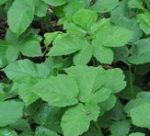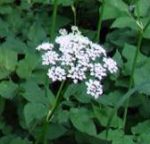 Also called goutweed, this rapidly growing herbaceous perennial is native to Eurasia but has been introduced into the US where it is often used as a ground cover. It is a member of the carrot family (Apiaceae) and related to parsley, dill, fennel, and Queen Anne’s lace. Although bishop’s weed prefers full sun and fertile moist soil it tolerates shade and dry, lean soil. A variegated from is more attractive, less aggressive but still invasive in moist conditions and may suddenly revert to the green form.
Also called goutweed, this rapidly growing herbaceous perennial is native to Eurasia but has been introduced into the US where it is often used as a ground cover. It is a member of the carrot family (Apiaceae) and related to parsley, dill, fennel, and Queen Anne’s lace. Although bishop’s weed prefers full sun and fertile moist soil it tolerates shade and dry, lean soil. A variegated from is more attractive, less aggressive but still invasive in moist conditions and may suddenly revert to the green form.
Description: Rhizomes produce erect, hollow, grooved stems eight to twelve inches tall, and deeply divided ivy-shaped leaves that quickly form dense mounds. The tiny cream- colored flowers are produced in umbels 2-4” across on long slender stems above the foliage from late spring to early summer. The oval fruits are about 1/16 “ long and split into two seeds when mature.
Control: Bishop’s weed spreads by seed and rhizomes with rhizomes being the most effective. Once established, bishop’s weed is difficult to control because even the smallest piece of rhizome left in the soil will give rise to a new plant. Digging out the rhizomes, therefore, is only helpful if followed by persistent mowing, hoeing, or hand pulling of new plants as they appear every 1-2 weeks, or covering the area with a dense mulch such as landscape cloth, cardboard, or newspaper. Any flowerheads that appear should be removed immediately to prevent the spread of the plant by seeds.